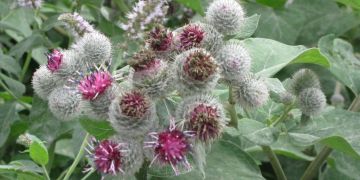Cultivation
The burdock in appearance is sometimes confused with cockle burr or even rhubarb, both members of the same family of plants, as is the artichoke. Dark green leaves shaped like hearts or large ovals often up to twenty eight inches in length jut from the hollow stems that can reach over a yard in length. The burdock flowers from June until October, turn into green or silver buds and purple blooms. After blooming, the seeds are enclosed inside the burr, which is equipped with sharp hooks. After the burrs are dispersed, the plant dies down.
Culinary use
In many parts of Asia, young burdock roots, flower stems and even very young leaves are consumed eagerly. The long thin root of the burdock is only a few centimeters wide but can reach over a meter in length are crisp and the taste is mild. They are best after thinly sliced and soaked in water to remove any bitter taste. There have been studies that the fiber of the burdock is a good aid to digestion. In the United Kingdom, it is combined with dandelion to make traditional soft drink that is quite popular today.
Medicinal use
The burdock is also known by many other names, most having to do with the characteristics of the seeds or traditional herbal uses; beggar's buttons, love leaves, clot-bur. Herbalists and others have long known that burdock is often used as a dietary aid to help cure different ailments such as sore throats, colds, blood purifiers, to combat hair loss and dandruff, to name a few. It also increases the flow of urine and is used as a tonic in mild doses and will increase sweating to remove toxins from the body.
Traditionally, the use of burdock as a medicine in China included the treatment of skin disorders, cleansing of the blood, as an effective treatment of impotence and barrenness in women. The use of the burdock root in Russia and India has also included treatment of certain types of cancer. The burdock is also a plant used in the treatment of burns, as it reduces pain and promotes healing.
Velcro
In the early 1940's, a Swiss inventor, George de Mestral was hiking with his dog and became intrigued by the burrs that clung tenaciously to his clothing and the dog's fur. The interaction of the sharp hooks of the burdock and loops of thread in his clothes inspired him to invent Velcro. The roots of the burdock are dark brown, gray or even black in appearance. The undersides of the leaves are covered with a downy like fuzz and can pose allergy problems for those allergic to marigolds and ragweed.
Warnings
The burdock is mentioned in several of Shakespeare's plays as in Tolstoy's writings as well as other authors of historical fiction who describe the use of burdock to treat various ailments. Caution should be used if you are childbearing or nursing, burdock could cause problems with both conditions.The properties of the burdock plant are still being researched and it is very important not to obtain plants from the wild unless you are entirely sure of what you are doing. The roots and leaves of nightshade which are poisonous if ingested, as are the leaves of the rhubarb plant; are members of the same family of plants as the burdock. It is vital that you make sure that the source of the parts of the burdock plant you are using be from a reputable source which has an excellent reputation of delivering high quality plants for use.





